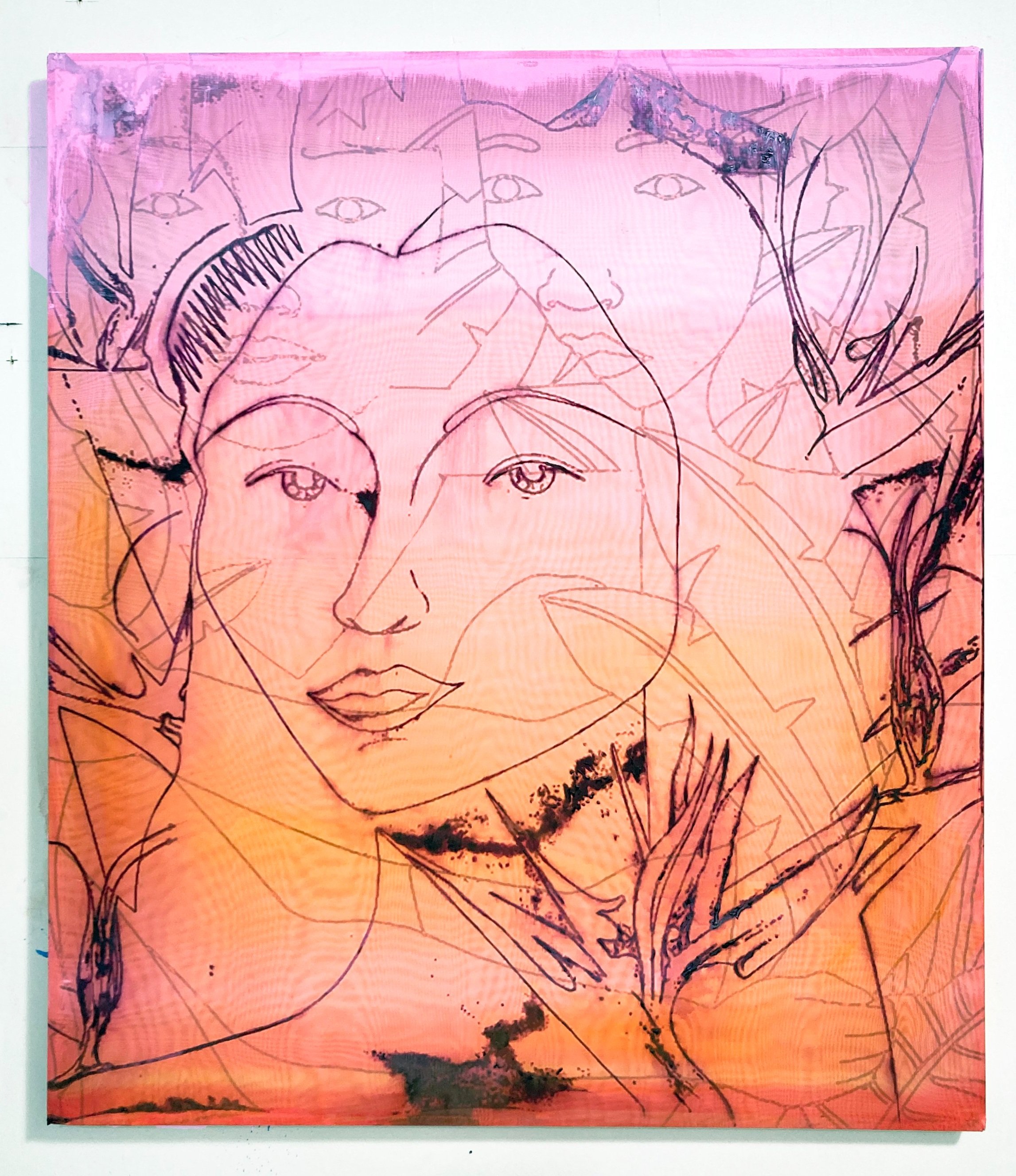Marcela Florido

In our latest feature, NYC-based artist Marcela Florido speaks to She Performs’ Curator, Lynn Seraina Battaglia, about her new body of work…
LSB: In October 2019, you participated in a wonderful Spotlight with She Performs. I think back to these works quite frequently, and I always find a calmness but also strength in them - both from the brushstrokes and the subjects of these paintings. Looking at your new works now, I am met with familiarity but also with a whole different confidence that these works exude.
This is not quite four years difference. A LOT has happened since then. How has your practice grown/changed in this time?
MF: Thank you so much for taking the time to look at my paintings and for sharing your feelings about them. Knowing that my art can evoke such positive emotions in others means the world to me. It's precisely what I aim to do with my paintings; thank you for your kind words.
Sadly, for most of us, the world changed a lot between 2019 and2023. COVID-19 completely shattered multiple aspects of life; these four years had the intensity, trauma, and grief of four decades. They have profoundly impacted my life and, as a result, my art. I had the privilege of being able to shelter in place and stay healthy during the lockdown. Most days, I sat in solitude, making drawings to occupy time, meditating, and giving language to the new feelings I was experiencing. After getting back to the studio, it took a while for this new language to find its way into my practice, because there were so many layers of unconscious learning and feelings. Now that I have perspective and distance from the works I made during that time, I can more clearly identify some of the shifts and themes that emerged then.
Amidst the confinement of lockdown, I was forced to confront the digital veil that stands between me and my home country. My art has always reflected the intimate connection of my body to Brazil's landscape, but being unable to physically return home for three long years, I was forced into a new relationship with the space that had so deeply inspired me. In some of the new paintings, Rio's lush and verdant landscape that was fully immersive in previous paintings, is either fragmented or dissolving with the fluidity of paint. This treatment of the landscape makes it feel more like a remembered or fantasized ideal, rather than a lived experience.
The sudden immersion in the digital world also affected my relationship with my own image: n my new self-portraits, I depict the character's face in a large, flat manner, mirroring the distorted way our faces appear on screens. Social media aesthetics, filters, and image-manipulation tools really influenced my self-portraits.. On the one hand, they opened up new avenues for self-expression and creativity, allowing me to explore new possibilities in my art. But they also created unrealistic beauty standards and a distorted sense of reality. I was terrified to learn that, during the lockdown, many women went through aesthetic procedures to change their faces because they did not recognize themselves in the image they saw on the screen. In a time when technology and social media have fundamentally changed how we see and present ourselves to the world, self-portraiture takes on a new significance.
The intense feelings of loneliness, grief, sorrow, and vulnerability – and the resulting , resilience, the desperate need to feel joy, feel confident, and live life at its fullest again – I hope it’s all reflected in my new paintings.
LSB: I briefly have to stay on the subject of confidence in these works. Zoomed in faces on large-scale canvases, morphing their surroundings into themselves. The physical body is less present than in older works, yet the physical presence of these works is stronger than ever.
How has your approach to the canvas and your subjects changed? Does the body still influence your work in the same way?
MF: For a long time, I was very concerned with how a particular audience would receive my paintings and determined to make them appear smart or clever. I felt that every move I made towards freedom and pleasure had to be conceptualized and contextualized. But my approach has shifted in recent years, I think partly because my understanding of time changed during lockdown. This shift towards making art that brings me joy and satisfies my artistic vision feels like a natural, almost unconscious result of all we have gone through.
The felt presence that you mention, I think, refers to this shift from a more objective representation of the body to a more subjective and introspective approach. In my new paintings, I no longer represent the body as a static object, but instead as an expansive and complex entity that encompasses both the subjective inner experience of oneself and the objective experience of others observing oneself from the outside. This emulates the experience of constantly seeing oneself reflected in screens, zooms, facetime, and social media. There is an estrangement between the way a body is observed and the experience of embodiment that I am trying to convey in these new works.
This shift in perspective can be compared to Lacanian mirror theory, which posits that the self is formed through the reflection of the body in the mirror, creating a sense of self-awareness and a split between the perceived self and the subjective self. Today, though, all the screens and digital devices function as this metaphorical mirror. So I paint the body not simply as a physical form but as a multi-layered and ever-changing entity that incorporates elements of the surrounding landscape into itself; it is expansive, occupying more space and breaking free from the limitations of a traditional, static representation. If my new paintings exude confidence as a result, then I am thrilled.
LSB: One major change in your work is the subject of superimposition. This can be found in this new body of works - from overlaid transparent canvas to flowers and stars superimposing the faces on the big paintings. There is an interaction of environment and subject. Especially in the bigger works (oil on canvas), the body seems to become the environment in which nature thrives. At the same time, the smaller works question the body's raison d'etre.
How has the introduction of superimposition changed or influenced your narrative? And how would you describe your relationship with the representation of landscape (nature) in these new works?
MF: The superimposition of graphic elements such as stars, hearts, and flowers in my new paintings significantly shifts their narratives and overall aesthetics. This move echoes the stickers and filters found in social media, which have introduced new modes of self-expression and creativity. It’s also been a fun way for me to reference other art movements, artists, and traditions that have influenced my work.
In two recent large oil paintings, I use f stars and hearts floating over the picture plane in a pattern that obstructs the viewer's gaze as it searches for the main character's face. This complicates the work's composition by adding depth and complexity. It also creates visual play between the internal and external experiences of the body. I incorporate these elements to explore the impact of technology on our sense of self.
In another painting called "Flor de Jasmin," elements like flowers and her sweater serve as apertures, or openings, that bring details from Matisse and Lygica Clark' works into dialogue with my own. So, in some cases, superimposition allows me to reference different artistic traditions and styles, creating a narrative that encompasses elements from my work and theirs.
In my large paintings on silk, the superimposition is more literal. I am layering one or more paintings on top of each other to highlight the transparency of the material. The painting occurs when the viewer sees all these fragments stacked together into one image – almost like a sculpture.
These new paintings feature large, colorful people and foliage on a soft-edged background of vibrant monochrome. The bold brushstrokes and atmospheric quality invite the viewer to contemplate the layered composition. The process of superimposition in these works encourages the viewer to slow down and appreciate the rich layers of paint and color as they relate to landscape.
LSB: There are different levels of detail in these works. The works on transparent canvases are the least detailed ones when it comes to the subject. Yet, they intrigue with a strong narrative that I attribute partly to seemingly seeing your hand in them so much more.
Please tell me more about these works. What are the process of the canvass and its staining? How did you arrive at these works?
MF: As I stare at the latest large-scale paintings in my studio, they seem to be playful, whimsical, and bold. These paintings continue to feature my recurring cartoonish pseudo-self-portrait character, which has been the subject of my art for the past three years. However, this new collection delves deeper into the interplay between color, form, and texture in a fresh and exciting way.
Ever since the summer of 2022, I have been experimenting with painting on silk. It was a steep learning curve, as this material behaves quite differently than canvas
When I first started playing with silk, I only had a vague idea of the atmosphere I wanted to create. But, as I experimented with the materials, a world of creative possibilities opened up to me. It was fascinating to observe how the colors interacted with the transparent material, and I found myself intrigued by the unique effects I could achieve. I began with small tests on a stretched patch of silk, gradually building up my skill until a drawing began to emerge from the abstract composition.
What I find most compelling about the creative process on silk is how one brushstroke leads to another, and ideas emerge organically as I work. Painting continues to be a fun, mysterious, and endlessly interesting journey for me.
















